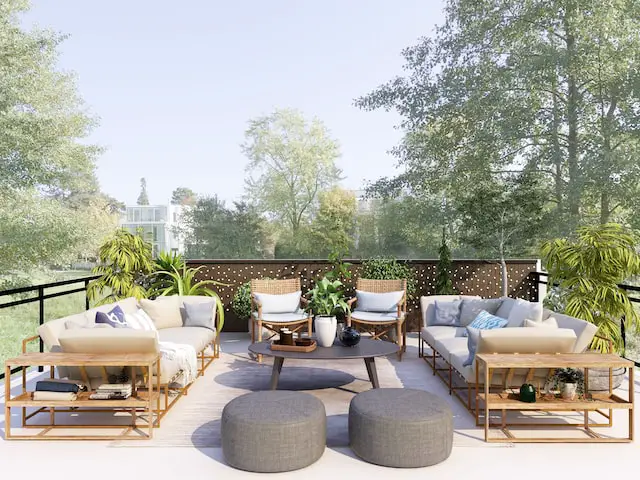Patios tend to be larger than porches and don’t require as much upkeep or maintenance, making them ideal for entertaining guests or having outdoor parties. Porches provide more protection from the elements while giving homeowners an added sense of privacy, but they need regular maintenance in order to remain functional and pleasing to look at.
What is a patio?
(Photo by Cameron Smith on Unsplash )

A patio is an outdoor living space or paved area that is typically located next to a house, apartment, or other building. Patios are often used for dining, entertaining, or relaxing, and can be made from a variety of materials such as concrete, stone, brick, or pavers. They may be covered or uncovered, and may feature furniture, plants, and other decor. Patios are a popular feature in many homes and can provide a great space to enjoy the outdoors and spend time with family and friends.
What is a porch?
(Photo by Francesca Tosolini on Unsplash )

A porch is a roofed, outdoor area adjoining the entrance of a home. Porches are typically built at the front or side of a house and may be enclosed or unenclosed. Porches provide protection from the elements and can be a great spot to relax and enjoy the outdoors. They can also be used for entertaining guests or as an extension of your indoor living space.
Patio Vs. Porch – Key differences
There are a few key differences between patios and porches. Patios are typically made of concrete, stone, or brick and are not attached to the house. Porches are usually made of wood and are attached to the house. Patios are generally used for outdoor dining and entertaining, while porches are typically used for relaxation. Porches often have roofs, while patios do not.
Patio and porch are both outdoor living spaces, but they differ in several key ways:
- Location: A patio is typically located on the ground level and is usually situated adjacent to a house, while a porch is typically elevated and attached to the front, side, or back of a house.
- Construction: A patio is usually constructed with concrete, stone, or pavers, while a porch is typically made of wood or other materials that can support the weight of the porch roof.
- Function: Patios are often used for outdoor dining, entertaining, or relaxation, while porches are often used as an extension of indoor living space, such as a place to sit and enjoy the view or read a book.
- Design: Patios can be designed in a variety of styles, including modern, rustic, or traditional, while porches often have a more classic or traditional design.
- Privacy: Patios are often more open and exposed to the surrounding environment, while porches are often enclosed or screened for privacy and protection from insects.
The key differences between patios and porches come down to their location, construction, function, design, and privacy. Both can be great outdoor living spaces, but they serve different purposes and have different features.
What are the benefits of a patio and porch?
Both patios and porches can offer a number of benefits to homeowners, including:
- Expanded living space: A patio or porch can provide additional living space for relaxing, entertaining, and enjoying the outdoors.
- Increased home value: A well-designed and constructed patio or porch can add value to a home and make it more attractive to potential buyers.
- Enhanced curb appeal: A beautiful patio or porch can improve the appearance of a home and add to its curb appeal.
- Connection to nature: Both patios and porches can provide a connection to the natural environment and allow homeowners to enjoy fresh air, sunshine, and the beauty of their surroundings.
- Health benefits: Spending time outdoors has been shown to have numerous health benefits, including reduced stress, improved mood, and increased vitamin D levels.
- Entertainment: A patio or porch can be a great place for entertaining friends and family, whether for a casual BBQ or a more formal dinner party.
- Low maintenance: Depending on the materials used, patios and porches can be relatively low maintenance, requiring only periodic cleaning and upkeep.
A well-designed and constructed patio or porch can provide numerous benefits to homeowners, both in terms of aesthetics and practicality.
What are the disadvantages of a patio and porch?
Though patios and porches can offer many benefits to homeowners, they also have a few potential disadvantages to consider:
- Cost: The cost of building a patio or porch can be relatively high, depending on the materials used and the complexity of the design.
- Maintenance: Depending on the materials used, patios and porches may require periodic cleaning, sealing, or other maintenance to keep them looking their best.
- Weather dependence: Patios and porches are typically exposed to the elements, so they may be unusable during extreme weather conditions, such as heavy rain or extreme heat.
- Insect and pest problems: Depending on the location and design of a patio or porch, they may be more susceptible to insect or pest problems, which can be difficult to control.
- Limited privacy: Patios and porches are often located close to neighbors or public areas, so they may offer limited privacy unless additional screens or barriers are installed.
- Limited use: Depending on the climate and seasonal weather patterns, patios and porches may only be usable for a portion of the year, limiting their overall usefulness.
The disadvantages of patios and porches may not outweigh their benefits, they should be carefully considered before investing time and money into their construction.
What are the different types of patios?
| PORCHES | PATIOS |
|---|---|
| Front porch | Concrete patio |
| Screened porch | Brick patio |
| Sunroom | Stone patio |
| Sleeping porch | Paver patio |
| Wrap-around porch | Tile patio |
| Back porch or deck | Wood patio |
How to choose the right one for your home?
If you’re unsure whether a patio or porch is right for your home, there are a few things to consider. First, think about how you want to use the space. If you’re looking for a place to entertain guests or relax outdoors, a porch may be a better option. Porches typically have more space and offer amenities like furniture and ceiling fans. On the other hand, if you’re simply looking for a place to enjoy the outdoors, a patio may be sufficient.
Another thing to keep in mind is the maintenance required for each type of outdoor space. Patios are typically made of concrete or stone and don’t require much upkeep. Porches, on the other hand, may be made of wood or composite materials and require regular cleaning and sealing to prevent weather damage.
Finally, consider your budget when deciding between a patio and porch. Patios are generally less expensive than porches, but both can range in price depending on materials and size.
Choosing between a patio and porch for your home is ultimately a matter of personal preference. Consider how you want to use the space and what kind of maintenance you’re willing to do before making a decision.
What is the difference between patio and porch and balcony?
A patio is a paved outdoor area adjoining a house, generally used for dining or recreation.
A porch is a covered or partially covered entrance to a house or building.
A balcony is an elevated platform, often enclosed, projecting from the wall of a building and affording a view.
What is the difference between veranda patio and porch?
The main difference between a veranda and a patio is that a veranda is typically attached to the house, while a patio is not. A veranda also has a roof and may be enclosed, while a patio is usually open to the elements. Verandas are common in warm climates, where they provide protection from the sun and rain. Patios are more commonly found in cooler climates.
What is the difference between porch and sunroom?
Porches are typically attached to the front of a home, while sunrooms can be attached to the front, back, or side of a home. Porches are also usually (but not always) covered, while sunrooms are typically made mostly of glass and are not covered. Finally, porch ceilings are often lower than sunroom ceilings.
What is the difference between courtyard and patio?
A courtyard is typically an enclosed outdoor space that is located within the walls of a building or surrounded by other structures, while a patio is typically an open outdoor space located adjacent to a house. Courtyards are generally larger, more private, and more architecturally intricate than patios, which are often simpler and designed for outdoor living and entertainment.
What is the difference between terrace and patio?
A patio is a paved outdoor area that is usually attached to your home. It can be used for dining, entertaining, or simply relaxing. A terrace is also an outdoor space, but it is not attached to your home. It is usually located on the second or third floor of a building and has a railing.
Featured Image By – Photo by Collov Home Design on Unsplash








